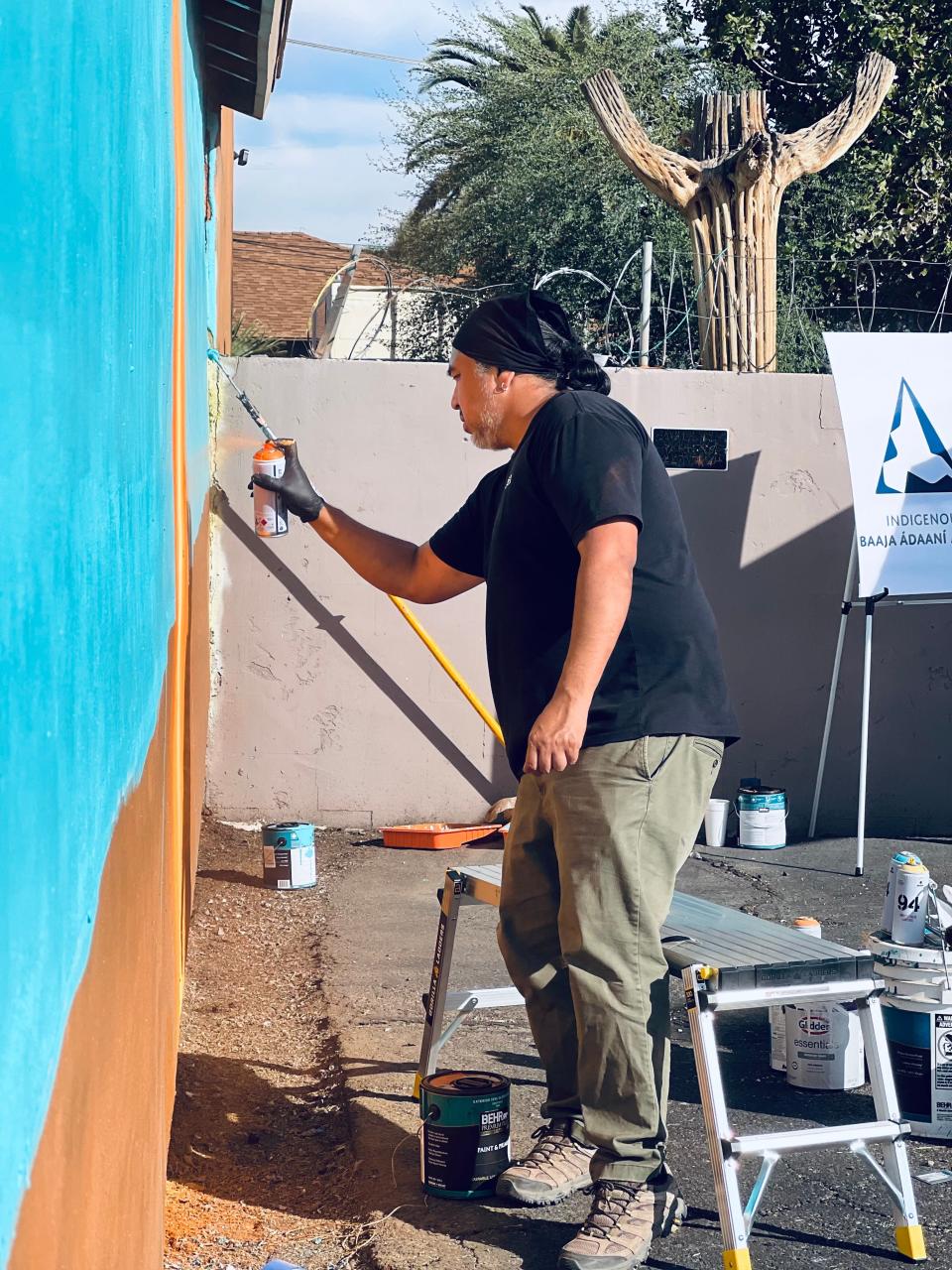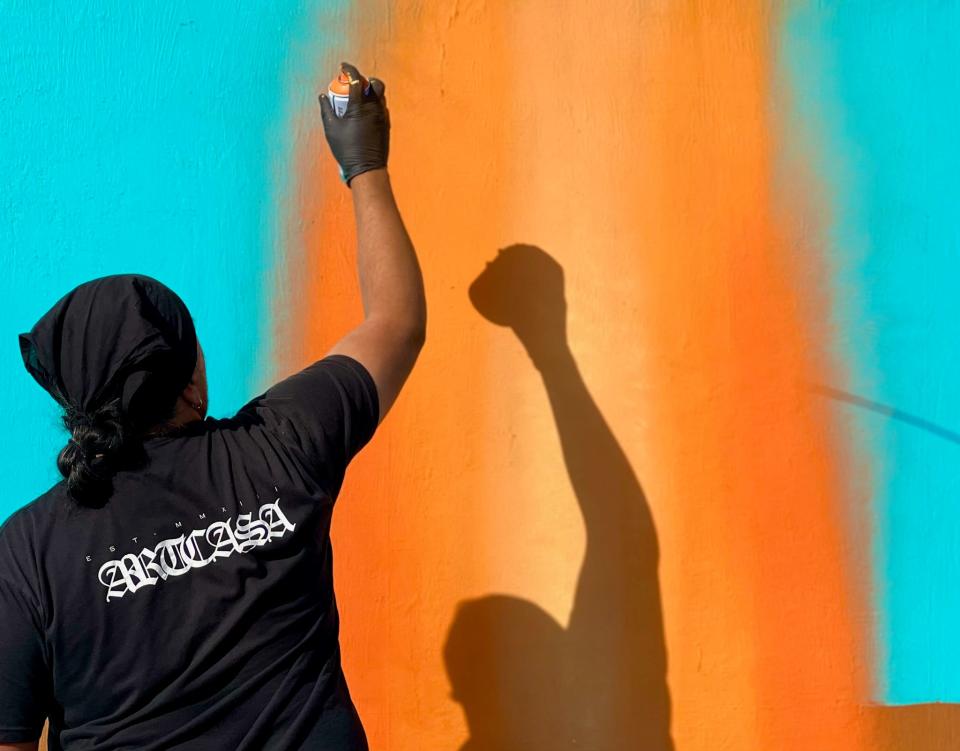2 Native artists won't display work at a Mesa museum after the city reschedules exhibit
- Oops!Something went wrong.Please try again later.
Two Indigenous artists say they won't display their work at a Mesa museum, even after the city changed course on an exhibit that was abruptly postponed in July.
Thomas “Breeze” Marcus and Douglas Miles declined an invitation from Mesa officials to include their art in the exhibit, which opened earlier this month. They said they were discouraged by what happened earlier this year and felt undervalued by the city.
“They had postponed the exhibit two months ago, and then you look back and you see the articles online and see there was a great public outcry about it,” said Miles, who is San Carlos Apache. “And then they rescheduled it after the public outcry. Once they rescheduled it, they asked me and as time went on I didn’t want to be a part of it anymore. I was disappointed with the way things were handled and disheartened by it too. They really devalued my art practice and work.”
Marcus, who is Tohono O'odham, said the work he created will now never be seen in its intended form.

In July, the Mesa Contemporary Arts Museum abruptly postponed the anticipated exhibit, which was to feature two world-famous artists, Swoon and Shepard Fairey, along with Marcus and Miles, two prominent Indigenous artists from Arizona.
In an email sent to Marcus and Miles, city officials said they were delaying the original exhibit due to aspects of the exhibitions that still needed to be finalized. Postponing it would give the city and the museum time to work out details “to ensure the quality of experience our community deserves and has come to expect.”
There had been requests to remove one piece by Fairey that depicted a skeletal police officer in riot gear holding a large flower. The decision drew backlash from the art world, and attention from the Arizona chapter of the ACLU, which suggested the exhibit was postponed due to censorship.
“Government-run agencies may determine what arts projects to fund and display, but their First Amendment obligations explicitly prevent them from denying projects with messages they dislike while permitting those they support,” the ACLU letter said.
ACLU Arizona didn't respond to The Republic's questions about the rescheduled exhibit.
Exhibit will still include controversial piece

The city decided to reschedule the show for early October, and "extended invitations to all artists to return to the museum for the rescheduled exhibition dates and sought ways to ease inconveniences caused by the delay,” said Amanda Urrea, public relations manager for Mesa’s Art Center in an email to The Republic.
Miles and Marcus were approached again to show their work at the rescheduled exhibit, but they decided the damage was done and declined.
“I told the city of Mesa it was unrealistic for me to participate with the original works I had intended for it,” said Marcus. He had worked over a year to create the work he intended for the exhibit and found that “the only option was an alternative that I knew they wouldn't go for but I pitched it anyway. When they said they wouldn't be able to do that, that’s when I said we can cut all ties.”
The rescheduled exhibit, named "Just Cause: The Power of Contemporary Art in Social Engagement," will run until January. Other artists featured in the exhibit are Russell Biles, Christian Black, Aaron S. Coleman, Sarah Conti, Jennifer Ling Datchuk, Michelle Erickson, Patrick Earl Hammie, Josh Keyes, Kris Kuksi, Annie Lopez, Narsiso Martinez, Jacob Meders (Mechoopda/Maidu), Gabriel Garcia Roman and Alexi Torres.
The Fairey piece that triggered the backlash and was the cause for the postponement is still part of the exhibit, according to Urrea.
Miles said the extensive artwork he created for the exhibit, which required assistance from others because of the size and weight of the canvases, is currently in storage. He hopes it can either be sold or find a new home in another exhibit or gallery.
“It’s gathering dust,” said Miles. “I don’t have plans for it at the moment. I am open to anyone that wants to show it. I am open to other offers for it, or collectors, other institutions who want to see it. I am always open to that.”
As for Marcus, the projects he designed were tailored to fit the museum's specific dimensions and have all been sent to various galleries separately. They will never be displayed together as originally intended, he said.

“I was able to send a couple pieces to another gallery,” said Marcus. “So, that body of work I have broken up and sent out to various places. Unfortunately, It will never be seen as a whole as it was intended to and created to fit that specific gallery space.”
Artists say the incident devalued Indigenous art
Fairey and Swoon are renowned for their advocacy art. Fairey, in particular, has created artwork featuring individuals from diverse ethnic backgrounds, including Indigenous people. His "We the People" series and another piece titled "The Black Hills" are notable examples of this, but Marcus and Miles said when it came to speaking out about the postponement and the negative effects on the artists, Fairey said nothing.
“Silence is compliance,” said Marcus. “When it comes to someone like Shepherd Fairey, who bases his whole entire persona on this kind of against-the-grain, sort of want-to-be-a-rebel artist, and has made a name for himself worldwide for it, but when push comes to shove he was completely silent over this.”
Fairey did not respond to attempts by The Republic to seek comment.
Both Marcus and Miles believe the controversy surrounding the event generated significant attention and publicity for the rescheduled show, as well as for Swoon and Fairey. They both expressed the view that, in the end, it didn't really matter to others what happened to the Native artists, especially considering they were left waiting for a month by the curator.
“When somebody is in the arts and their job is a curator you should really look out for your artists,” said Marcus. “All this did was give him (Fairey) more publicity. This entire episode is not about one piece, it's about an entire system rooted in conservative, racist, institutional values by city management.”
Last November, Eric Descheenie, executive director of Indigenous Baaja Ádaaní Al Son, the first statewide tribal political organization in Arizona, was able to get Marcus to create a mural on the Frybread House in Phoenix to represent the Native vote.
He said he is disappointed at what Marcus and Miles have gone through with Mesa, and said the reason he chose Marcus to draw the mural for his organization was because his work stands out. Marcus has created murals in practically every city in metro Phoenix.
“When I think of artists who are Indigenous to these lands, I immediately think of how Native people are art,” said Descheenie. “Everything we do is rooted in some form of art, be it painting, weaving rugs, putting together baskets, storytelling, singing chants in ceremony, sandpainting, the list goes on and on. Everything we do is art. We embody art.”
Miles said the draw for him to show in the exhibit was Marcus, and once he found out he wouldn’t be in the show it solidified his decision to not be a part of the new exhibit at all.
“I didn't want to be in the show if he wasn't in the show,” said Miles. “To me what was the biggest, most exciting part of the show was that I would get to show alongside an artist of his caliber. For him not to be in it, for me, it was disappointing.”
In the end, Swoon and Fairey will have their work showcased, and this moment won't significantly affect their already global recognition. But Marcus and Miles, two Arizona-based artists who have created art and collaborated closely with their local communities, say the situation highlights the minimal consideration that museums often give to Indigenous art and artists.
"I didn't feel they valued out work," said Miles. "Not only our work, but our work in the community that we've been doing for many years."
Arlyssa Becenti covers Indigenous affairs for The Arizona Republic and azcentral.com. Send ideas and tips to arlyssa.becenti@arizonarepublic.com.
Support local journalism. Subscribe to azcentral.com today.
This article originally appeared on Arizona Republic: 2 Native artists say they won't display work at a Mesa museum

